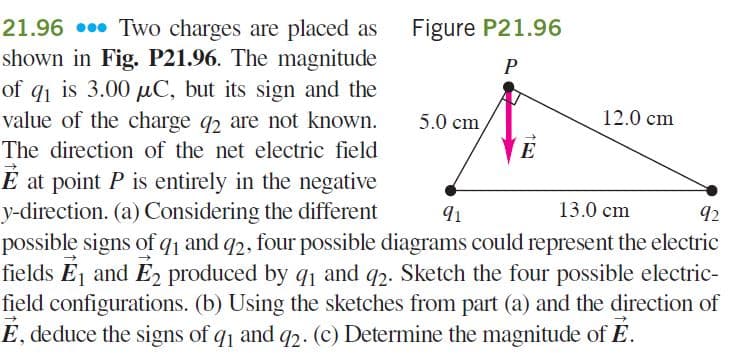21.96 •. Two charges are placed as Figure P21.96 shown in Fig. P21.96. The magnitude of q1 is 3.00 µC, but its sign and the value of the charge q2 are not known. P 5.0 cm, 12.0 cm The direction of the net electric field E É at point P is entirely in the negative y-direction. (a) Considering the different possible signs of qı and q2, four possible diagrams could represent the electric fields Ej and E2 produced by q1 and q2. Sketch the four possible electric- field configurations. (b) Using the sketches from part (a) and the direction of E, deduce the signs of q1 and q2. (c) Determine the magnitude of E. 91 13.0 cm 92
21.96 •. Two charges are placed as Figure P21.96 shown in Fig. P21.96. The magnitude of q1 is 3.00 µC, but its sign and the value of the charge q2 are not known. P 5.0 cm, 12.0 cm The direction of the net electric field E É at point P is entirely in the negative y-direction. (a) Considering the different possible signs of qı and q2, four possible diagrams could represent the electric fields Ej and E2 produced by q1 and q2. Sketch the four possible electric- field configurations. (b) Using the sketches from part (a) and the direction of E, deduce the signs of q1 and q2. (c) Determine the magnitude of E. 91 13.0 cm 92
College Physics
1st Edition
ISBN:9781938168000
Author:Paul Peter Urone, Roger Hinrichs
Publisher:Paul Peter Urone, Roger Hinrichs
Chapter18: Electric Charge And Electric Field
Section: Chapter Questions
Problem 46PE: (a) Using the symmetry of the arrangement, determine the direction of the electric field at the...
Related questions
Question

Transcribed Image Text:QUESTION 6
In problem 21.96 of your book, University Physics 15th edition (see End of the Chapter 12 section), what is the magnitude of the electric
field (in N/C)? (Don't use scientific notation for expressing a very small or very large number)

Transcribed Image Text:21.96 0. Two charges are placed as
shown in Fig. P21.96. The magnitude
of q1 is 3.00 µC, but its sign and the
value of the charge q2 are not known.
Figure P21.96
P
5.0 cm
12.0 cm
The direction of the net electric field
E
É at point P is entirely in the negative
y-direction. (a) Considering the different
possible signs of q1 and q2, four possible diagrams could represent the electric
fields Ej and E produced by q1 and q2. Sketch the four possible electric-
field configurations. (b) Using the sketches from part (a) and the direction of
E, deduce the signs of q1 and q2. (c) Determine the magnitude of E.
91
13.0 cm
92
Expert Solution
This question has been solved!
Explore an expertly crafted, step-by-step solution for a thorough understanding of key concepts.
This is a popular solution!
Trending now
This is a popular solution!
Step by step
Solved in 2 steps with 2 images

Knowledge Booster
Learn more about
Need a deep-dive on the concept behind this application? Look no further. Learn more about this topic, physics and related others by exploring similar questions and additional content below.Recommended textbooks for you

College Physics
Physics
ISBN:
9781938168000
Author:
Paul Peter Urone, Roger Hinrichs
Publisher:
OpenStax College

Physics for Scientists and Engineers, Technology …
Physics
ISBN:
9781305116399
Author:
Raymond A. Serway, John W. Jewett
Publisher:
Cengage Learning

College Physics
Physics
ISBN:
9781285737027
Author:
Raymond A. Serway, Chris Vuille
Publisher:
Cengage Learning

College Physics
Physics
ISBN:
9781938168000
Author:
Paul Peter Urone, Roger Hinrichs
Publisher:
OpenStax College

Physics for Scientists and Engineers, Technology …
Physics
ISBN:
9781305116399
Author:
Raymond A. Serway, John W. Jewett
Publisher:
Cengage Learning

College Physics
Physics
ISBN:
9781285737027
Author:
Raymond A. Serway, Chris Vuille
Publisher:
Cengage Learning

Principles of Physics: A Calculus-Based Text
Physics
ISBN:
9781133104261
Author:
Raymond A. Serway, John W. Jewett
Publisher:
Cengage Learning

College Physics
Physics
ISBN:
9781305952300
Author:
Raymond A. Serway, Chris Vuille
Publisher:
Cengage Learning

Physics for Scientists and Engineers: Foundations…
Physics
ISBN:
9781133939146
Author:
Katz, Debora M.
Publisher:
Cengage Learning